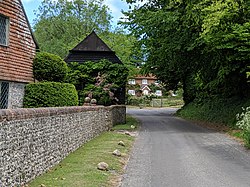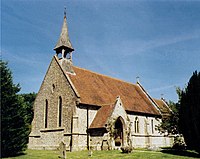Shalden
| Shalden | |
| Hampshire | |
|---|---|
 The lane to The Old Forge, Shalden | |
| Location | |
| Grid reference: | SU696420 |
| Location: | 51°10’25"N, 1°0’20"W |
| Data | |
| Population: | 435 (2011) |
| Post town: | Alton |
| Postcode: | GU34 |
| Local Government | |
| Council: | East Hampshire |
| Parliamentary constituency: |
East Hampshire |
Shalden is a village in Hampshire, in east of the county, two miles north-west of Alton, its nearest town, and two miles north-east of Bentworth, just off the A339 road.
The parish contains four individual hamlets; Stancombe, Shalden Green, Pountley and Golden Pot, and all together the 2011 census recorded a parish popualtion of 435.
The village once had a Saxon church, but it was destroyed and replaced with a newer church, built in 1863. The landscape hereabouts is dominated by farms and woodland such as Shalden Manor, Glenville Farm and Oldale Wood. The soil is of clay and chalk, with a subsoil of chalk, and the prominent crops produced in the area are cereals.
A large number of old chalk pits indicate that the chalk was once worked in the parish.
History
Ancient and mediaeval
Bronze Age remains found in the area include a looped palstave and a cinerary urn.[1] Of the Roman period, in the village,[2] with several Roman coins and pottery remains being found near Shalden school in 1905.[1] There is further evidence to suggest that a Roman villa was once constructed in or near the village.[1]
The manor of Shalden is recorded in the Domesday Survey of 1086, included in the Odiham Hundred, as owned by William Mauditt of Hanslope.[2] It had formerly been in the ownership of four freemen of the King Edward as an "alod".[3]
The village name has been spelled in various ways, including Seldene (11th century), Schalden, Scaldeden, or Scaudedene (12th century), and Chalden or Scalden (13th century).[3]
The ownership of the manor was eventually passed to the descendants of William Mauditt alongside the manor of the nearby hamlet, Hartley Mauditt, of which the manor of Shalden was held under. The manor was apparently held by the Mauditt family of Hartley Mauditt until near the end of the 12th century, when William Mauditt gave the manor to his brother Robert Mauduit of Warminster, to be held by William and his heirs for the service of half a knight's fee. Robert Mauditt died in 1191, and his son and successor Thomas was holding the manor between 1235 and 1236. He died in 1244, and was succeeded by his son, also named William.[3]
William Mauditt left a son and heir, Warin, a minor, whose custody was assigned by Henry III to his brother Richard, Earl of Cornwall. During this time, Richard temporarily held the manor of Shalden from Henry until his death 1272. Consequently, Warin Mauditt held the manor until his death in either 1299 or 1300.[3] Interest in the manor passed down to his son Thomas, in which he granted a sum of land at Shalden to a Knight named Walter Stoner and his freeman, in gratitude for his homage and services. At that time Sir Nicholas de Boys held the manor of Shalden as a tenant for life. In 1297 the Earl of Cornwall, in consideration of the services of Sir Nicholas, granted the manor to him and his heirs indefinitely. Sir Nicholas paid nothing for the manor, though his heirs were to pay £12 a year.[3]
Modern Age
At the beginning of the 19th century, the manor of Shalden was passed to John Lewkenor and his wife, Anne, of whom it was eventually succeeded by their John, at an unknown point. The manor was then ceded on to the Knights of Chawton, in whose family it remained until 1840, when it was sold by Edward Knight to John Wood, the owner of Thedden Grange in Bentworth. Upon his death in 1871, it was finally renounced to his son John Gathorne Wood, who was the last owner of the manor from 1871 to some time after 1912.[3] In 1870–72 the Imperial Gazetteer of England and Wales by John Marius Wilson described Shalden as:
... a parish in Alton district, Hants; 2½ miles N W of Alton r. station. Post-town, Alton. Acres, 1, 509. Real property, £1, 396. Pop., 185. Houses, 37. The manor belongs to J. Wood, Esq. The living is a rectory in the diocese of Winchester. Value, £331.* Patron, the Lord Chancellor. The church is ancient.[4]
Parish church

The present church, St Peter and St Paul, was built in 1863, and is reminiscent of the 13th century in design. The bell-cot contains one modern bell. The old Saxon church stood a few feet to the south of the present one, and has been completely destroyed. The only piece of architecture that remains of the Saxon church is the font, which was re-used for the new church. The front dates from the 15th century and is of octagonal form, with a moulded octagonal stem and a panelled bowl.[3]
The old Saxon church was given by William Mauditt to the prior and convent of Southwick between 1147 and 1153. The grant was confirmed by Pope Eugenius III and Pope Urban III in 1185.[3] In the present church, a book of the registers contains baptisms from 1686 and marriages and burials from 1687, baptisms running to 1790, and marriages to 1753.[3]
The churchyard contains the Commonwealth war grave of a Machine Gun Corps soldier of First World War.[5]
Outside links
- A Vision of Britain Through Time: Shalden
- Shalden at Hampshire County Council
- Stained Glass Windows at St. Peter & St. Paul, Shalden, Hampshire
References
- ↑ 1.0 1.1 1.2 "British Archaeological Sites in Shalden". Archaeology UK. http://www.archiuk.com/cgi-bin/web-archi.pl?PlacenameFromPlacenameFinder=Shalden%20Green&CountyFromPlacenameFinder=Hampshire&distance=10000&ARCHIFormNGRLetter=SU&ARCHIFormNGR_x=70&ARCHIFormNGR_y=43&info2search4=placename_search&placename@digital-documents.co.uk.
- ↑ 2.0 2.1 "Conversation Area: Shalden". East Hampshire County Council. 1996. pp. 1–3. http://www.easthants.gov.uk/sites/default/files/documents/ShaldenConservationArea.pdf.
- ↑ 3.0 3.1 3.2 3.3 3.4 3.5 3.6 3.7 3.8 A History of the County of Hampshire - Volume 4 : pp101-103 (Victoria County History)
- ↑ "A history of Shalden in East Hampshire". University of Portsmouth. http://www.visionofbritain.org.uk/place/3372.
- ↑ [1] CWGC Casualty record, John George Miller.